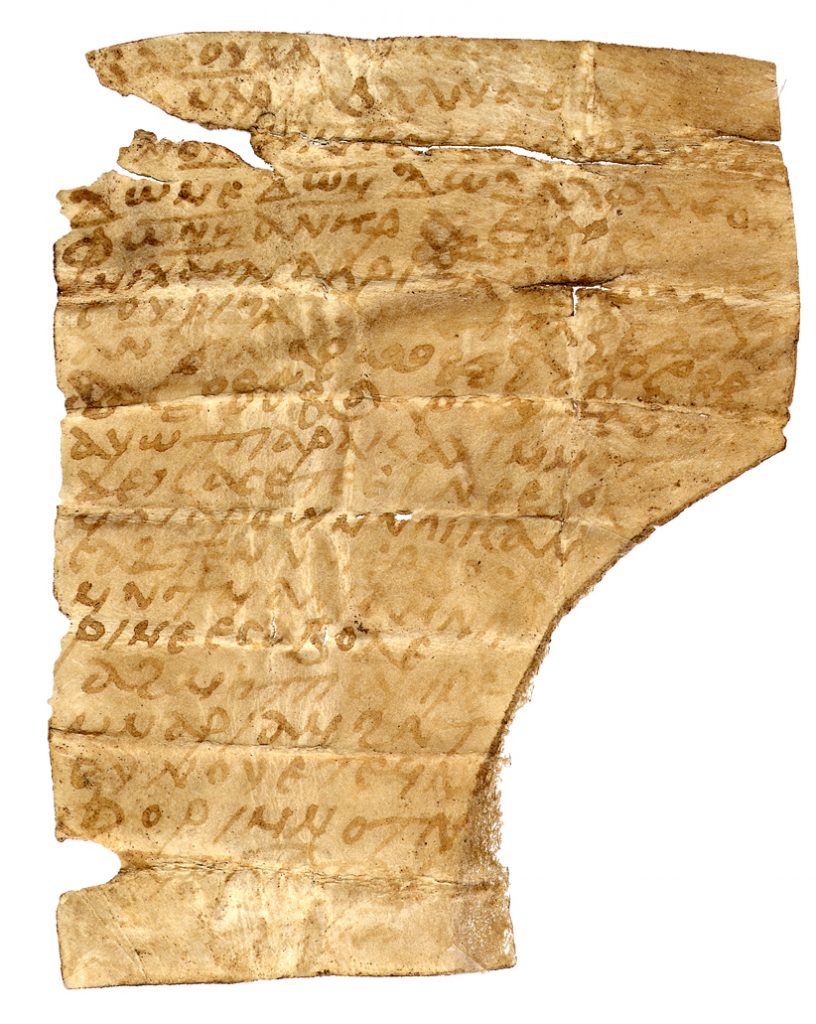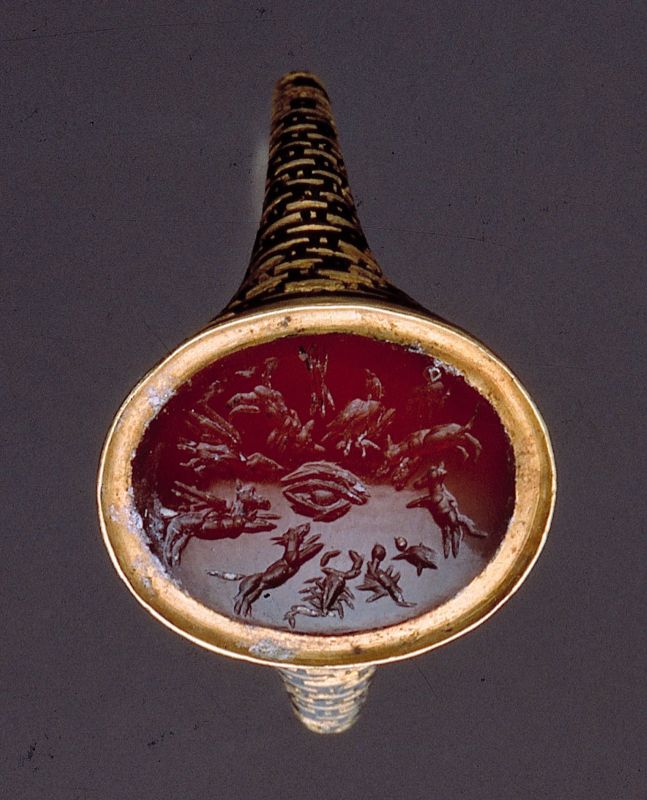This week’s post takes a deep dive into one example of a healing amulet from Kyprianos, our database of Coptic magical texts: P. Heidelberg inv. Kopt. 544b is a sheet of parchment, cut into a rough rectangle measuring 7.3cm by 6.5cm. This sheet was folded seven times horizontally and twice vertically, producing a tight package of c.1.1cm by c.2.5cm. As we will see, the text itself suggests that this package was to be worn by the client, Ahmed. The text’s 19 lines were inscribed upon the flesh side of the parchment, the inward-facing side of the skin, while the hair side, which would have faced outwards, was left blank.
The text was published by Hans Quecke in 1963, who was not confident in dating the text due to a lack of provenance and no clear dialectal or palaeographical features. But he did note that the client has the Arabic name Ahmed, and so a date into the Early Islamic Period (8th century CE onwards) seems most likely. Most of the other Coptic magical manuscripts in the Collection of the Heidelberger Papyrussammlung are mostly of the 10th and 11th century CE, and so we could imagine that this amulet was produced around that time too. A translation of this healing amulet into English appeared more recently in the collection of translations of Coptic Texts of Ritual Power by Marvin Meyer and Richard Smith, where it was translated by Neal Kelsey.

Baboucha … Akrama[kha]mari, Ablanathana … lion … ōne … Rankme, Dōme, Dōm, Dōd, Alpha, Leon, Phōnē, Anēr, aeēiouō, Michael, Gabriel, Raphaēl, Ēl, Souriēl, Zarathiēl, Zedeki, Anaēl, Uōēl, Tsēl, aeēiouō.
P. Heid. inv. Kopt. 544b
I entreat and I invoke you (pl.) so that you (pl.) bring out this cold and this spreading fire and these evil eyes and this distress and these tear(s) away from Ahmed, the son of Mariam, as soon as he will carry you (pl.). Yea, Yea! Quickly, Quickly!
This amulet opens with eight and a half lines of voces magicae, the “magical names” that invoke the particular deities and angels whose power will heal Ahmed. Notable among these names are those of archangels and angels, such as the commonly-found Michael, Gabriel, Raphael, and Souriel, as well as six other names, featuring the ending -ēl associated with angels. As identified by Gideon Bohak (2003), the most prominent scholar of Jewish magic, both real and constructed angelic names are commonly found among the voces magicae of Eastern Mediterranean magical traditions. This is particularly true for the Graeco-Egyptian magical papyri and continues to be the case among Coptic magical texts.
These beings are then invoked, in the plural, to “bring out” both cold and heat – highlighting both a fever of chills and a burning fever – in addition to the evil eyes, distress (Greek mania), and tears that are afflicting Ahmed. The command specifies not only that they should be “brought” “out”, but also “away” from Ahmed, ridding him of them, and healing him. The ritual act through which these afflictions will be removed from Ahmed is concretized not simply through the inscription of the command on the parchment and the vocalization of the command by the practitioner, but also through Ahmed carrying the parchment package as an amulet. The text closes that it is “as soon as he (i.e. Ahmed) will carry you (i.e. the invoked voces magicae)” that the commands will be actualized. Finally, the conventional closing formula reinforces the command that this healing is not to be waited on, but to occur at once.

A final feature of note is the name of the client. Although the client’s mother is called Mariam, a name common to both Christians and Muslims in Egypt, Ahmed himself has a Muslim name. As the historian Richard W. Bulliet notes in his study of conversion to Islam in Egypt (1979), Ahmed is a distinctively Muslim name. This text therefore serves as one piece of evidence of a practitioner who used Coptic-language magic having a clientele which included Muslims. Based on our knowledge of inter-communal relations, it is possible that Ahmed or his family were recent converts to Islam who retained links with the Christian community, but we also know that the magic of other religious communities is often seen as more effective. We even have evidence from early modern Egypt of Muslims deliberately seeking out Christian practitioners, and vice versa, and our recent post about a bilingual exorcism also cited contemporary evidence of Muslims seeking exorcisms from Coptic priests.
This short text is, then, yet another fascinating example of the more than 500 Coptic magical texts in Coptic that we are editing as part of our project, and another example of a story of an individual from centuries ago which we are (re)discovering as part of our work. We will continue to share these stories with you in this and related series of posts in the future.
Bibliography
Bohak, Gideon. “Hebrew, Hebrew Everywhere? Notes on the Interpretation of Voces Magicae.” In Scott B. Noegel, Joel Thomas Walker, Brannon M. Wheeler, (eds.), Prayer, Magic, and the Stars in the Ancient and Late Antique World, University Park, Pa. : Pennsylvania State University Press, 2003, 69-82. URL
Bulliet, Richard W.. Conversion to Islam in the Medieval Period: An Essay in Quantitative History. Harvard University Press: Cambridge, Massachusetts and London, England, 1979.
Meyer, Marvin W., and Richard Smith. Ancient Christian Magic: Coptic Texts of Ritual Power. Princeton (New Jersey): Princeton University Press, 1999, no. 54, p. 101.
Pernigotti, Sergio. “La magia copta: I testi.” In Aufstieg und Niedergang der römischen Welt, edited by Hildegard Temporini and Wolfgang Haase, II.18. 5., 3685–3730. Berlin and New York: Walter de Gruyter, 1995, no. 39, p. 3728.
Quecke, Hans. “Zwei koptische Amulette der Papyrussammlung der Universität Heidelberg.” Le Muséon no. 76 (1963): 247–265, pp. 248–254.
